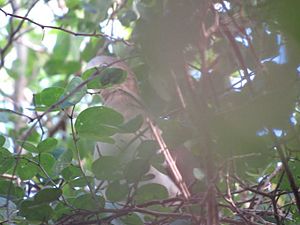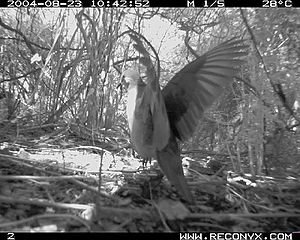Grenada dove facts for kids
Quick facts for kids Grenada dove |
|
|---|---|
 |
|
| Conservation status | |
| Scientific classification | |
| Genus: |
Leptotila
|
| Species: |
wellsi
|
The Grenada dove (Leptotila wellsi) is a medium-sized bird that lives in warm, tropical places. It only lives on the island of Grenada, which is in the Lesser Antilles in the Caribbean Sea. It's also called the pea dove or Well's dove, and it's the official national bird of Grenada. Sadly, it's one of the most endangered doves on Earth.
Contents
What it Looks Like
The Grenada dove has a white throat. Its face and forehead are light pink, turning to a dull brown on the top and back of its head. Its upper body is olive-brown, and the underside of its wings is a reddish-brown color. Its neck and upper chest are a pinkish-tan, fading to white on its lower chest, belly, and under its tail.
Where it Comes From
This special dove was first described in 1884. It became the official national bird of Grenada in 1991. The Grenada dove is now a very important flagship species for efforts to protect nature in Grenada.
Where it Lives
The Grenada dove is a unique bird found only on the main island of Grenada in the Caribbean. In the past, people saw these doves all over Grenada, even on small islands nearby. The first dove that was studied came from a place called Fontenoy, on the west coast.
Scientists believe that Grenada doves like to live in dry forests. These forests are mostly found in the western and southwestern parts of the island.
How it Behaves
Reproduction
Grenada doves are thought to be very protective of their living areas. Scientists use this idea to guess how many doves are left. Doves in the Mount Hartman area have been seen fighting, which shows they defend their space. Other doves like them also show how protective they can be. One person who kept these doves even saw a pair kill other doves that were put into their home.
So far, only one active Grenada dove nest has ever been found and studied.
What it Eats
Grenada doves have been seen eating Papaya fruit. They also eat mealworms, other fruits, seeds, and even grains from farms.
Protecting the Grenada Dove
We don't know a lot about the Grenada dove. Some studies suggest there might be fewer than 100 of these birds left in the wild. Their numbers might have gone down between 1987 and 1991. After Hurricane Ivan hit in 2004, even fewer doves were heard calling in their usual areas. For example, in one area, only five doves were heard calling in spring 2005, and only three in late summer 2005.
Because there are so few of them, BirdLife International has listed the Grenada dove as critically endangered. This means it's at a very high risk of disappearing forever.
To help save the dove, the Grenada Government worked with the World Bank. In 1996, they created two special protected areas where the doves can live safely.
Dangers to the Dove
The biggest danger to the Grenada dove is that its home is being broken up. This is called habitat fragmentation. As early as 1947, a scientist named James Bond said that human activities were destroying the homes of birds in the West Indies, making them rare or extinct.
Things like new buildings, farm animals eating plants, and people cutting down trees for firewood also hurt the dove's habitat. This happens because there aren't enough rules about land development. People have even found places where charcoal is being made right next to dove habitats, which damages the forest.
Besides losing their homes, predators also threaten the Grenada dove. Some animals that are not native to Grenada have been brought to the island. The common opossum, for example, might eat Grenada doves at any stage of their life. Other small animals like Marmosa species might eat their eggs in the nest.
Animals brought by European settlers also cause problems. These include rats, mongooses, Mona monkeys, and feral cats. Rats were the most common predator found in one study.
In the past, hunting might have affected the dove population, as it was once a game bird. However, hunting is not considered a major threat today.
See also
 In Spanish: Paloma montaraz de Granada para niños
In Spanish: Paloma montaraz de Granada para niños



